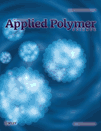Electroless nickel deposition of a palladium-activated self-assembled monolayer on polyester fabric
Abstract
In this study, an alternative Pd activation process was developed for electroless Ni plating on polyester fabric modified with a self-assembled monolayer (SAM) of 3-aminopropyltrimethoxysilane (APTMS). The presence of a highly oriented amino-terminated SAM and the formation of Pd-activated APTMS were demonstrated by X-ray photoelectron spectroscopy analysis. After activation, electroless Ni plating was successfully initiated, and the Ni coating was deposited onto the surface of the polyester fibers. The resulting Ni coating was examined by scanning electron microscopy, energy-dispersive X-ray spectroscopy, and X-ray diffraction. The electromagnetic interference (EMI) shielding effectiveness (SE) and adhesive strength of the Ni-plated polyester fabric were evaluated. On the basis of the experimental results, the Ni coating produced with a Pd-activated SAM was uniform and dense. As the Ni weight on the treated fabric was 32 g/m2, the EMI SE of the Ni-plated polyester fabric modified with APTMS obtained was more than 30 dB at frequencies that ranged from 2 to 18 GHz. Compared with the conventional two-step activation method, Ni coating on the Pd-activated polyester fabric modified with APTMS improved the coating adherence stability. © 2012 Wiley Periodicals, Inc. J. Appl. Polym. Sci., 2013




